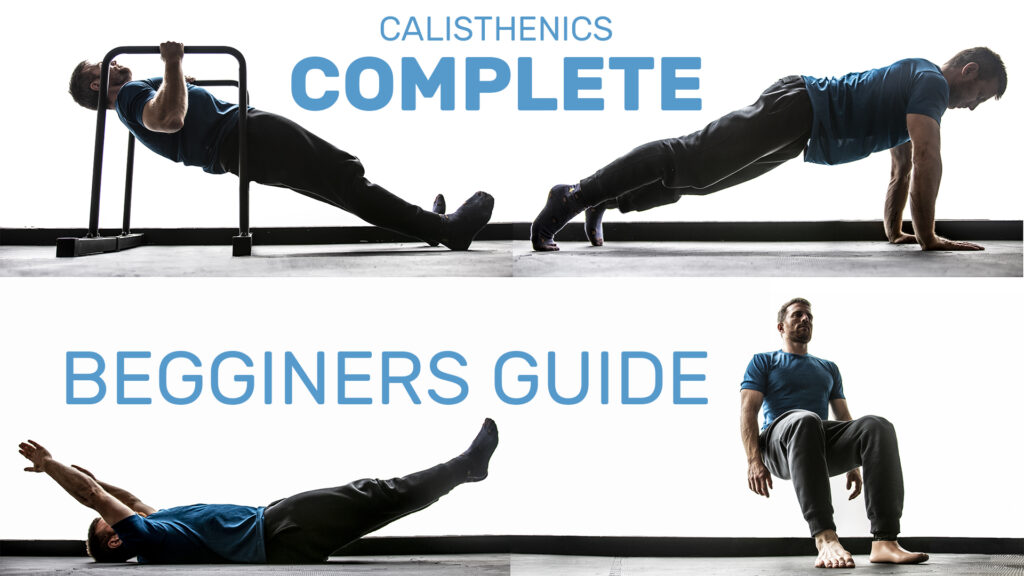If you’ve ever wondered how to get started with calisthenics, look no further. This article will provide you with all the essential tips and information you need to begin your calisthenics journey. Whether you’re a fitness enthusiast or a complete beginner, we’ll guide you through the basics of calisthenics and help you kickstart your training regimen. From understanding the benefits of calisthenics to discovering the fundamental exercises, we’ve got you covered. Get ready to unleash your inner strength and flexibility as you embark on this exciting fitness adventure.

This image is property of www.bodyweightmuscle.com.
Finding Motivation
Set a Goal
One of the first steps in getting started with calisthenics is to set a goal for yourself. Having a clear objective will help you stay motivated and focused on your fitness journey. Whether your goal is to lose weight, build muscle, increase flexibility, or improve overall strength, defining your goal will give you a sense of purpose and direction.
Find Inspiration
Finding inspiration can be a great way to stay motivated and committed to your calisthenics practice. Look for success stories, transformation photos, or videos of calisthenics athletes performing impressive moves. Following fitness influencers and communities on social media can also provide you with daily doses of inspiration and encouragement.
Create a Schedule
Creating a schedule is essential for making calisthenics a regular part of your routine. Decide on the time of day that works best for you and block off specific time slots for your workouts. Consistency is key, so try to stick to your schedule as much as possible. Having a structured routine will help you develop the discipline and commitment needed for long-term progress.
Assessing Your Fitness Level
Understanding Your Current Strength and Flexibility
Before jumping into a calisthenics program, it’s important to assess your current fitness level. Take some time to gauge your strength and flexibility by performing basic exercises like push-ups, squats, and lunges. This will give you a starting point to work from and help you track your progress as you continue with your calisthenics journey.
Evaluating Your Endurance
Endurance is another crucial aspect of fitness to assess. Perform exercises that require sustained effort, such as planks or burpees, and see how long you can maintain good form before fatigue sets in. Knowing your baseline endurance level will help you design workouts that gradually increase intensity and duration over time.
Checking Your Mobility
Mobility plays a significant role in calisthenics, as many exercises require a good range of motion. Assess your mobility by performing movements such as deep squats and overhead reaches. Pay attention to any restrictions or limitations in your joints and muscles. Identifying areas that require improvement will allow you to incorporate targeted mobility exercises into your routine.

This image is property of i.ytimg.com.
Preparing Your Body
Warm-up Exercises
To prevent injuries and prepare your body for physical activity, warming up is essential. Incorporate dynamic warm-up exercises into your pre-workout routine to increase blood flow, loosen up your muscles, and activate your nervous system. Examples of warm-up exercises include jumping jacks, arm circles, and high knees.
Stretching Routine
Stretching helps improve flexibility and range of motion, which are crucial for calisthenics movements. Focus on dynamic stretching before your workout to warm up your muscles further and static stretching after your workout to cool down and promote flexibility gains. Pay extra attention to the muscle groups you will be targeting during your workout.
Core Activation
The core is a vital area to engage in calisthenics, as it provides stability and strength for many movements. Prioritize core activation exercises during your warm-up to activate and engage your abdominal muscles. Planks, bird dogs, and Russian twists are great exercises to include in your routine to strengthen and stabilize your core.
Mastering the Basics
Perfecting Push-Ups
Push-ups are a fundamental calisthenics exercise that targets multiple muscle groups, including the chest, shoulders, triceps, and core. Focus on proper form and technique, keeping your body in a straight line and lowering yourself until your chest reaches the ground. Start with modified push-ups on your knees if needed, and gradually progress to full push-ups as you build strength.
Building Stability with Planks
Planks are excellent for building core strength and stability, making them an essential exercise in calisthenics. Start with shorter durations and gradually increase the time as you improve. Focus on maintaining proper form, keeping your body straight and engaging your core. Variations such as side planks and plank jacks can be incorporated once you’ve mastered the basic plank.
Learning Squats and Lunges
Squats and lunges are foundational movements that target the lower body muscles, including the quadriceps, hamstrings, glutes, and calves. Start with bodyweight squats and lunges to perfect your form before progressing to more challenging variations or adding weights. Pay attention to maintaining proper alignment and engaging the correct muscles throughout the exercises.

This image is property of i.ytimg.com.
Progressing to Advanced Movements
Gradually Increasing Reps and Sets
Once you have mastered the basics and built a solid foundation, it’s time to progress to more advanced movements. Gradually increase the number of repetitions and sets for each exercise to continue challenging your muscles and promoting growth. Progression is key for making consistent gains in calisthenics.
Incorporating Variations
Adding variations to your exercises is an excellent way to keep your workouts challenging and exciting. Explore different grips, foot positions, or tempos to target different muscle groups and add variety to your routine. For example, wide grip pull-ups or diamond push-ups can provide a unique stimulus for your muscles.
Learning Handstands and HSPUs
Handstands and handstand push-ups (HSPUs) are advanced calisthenics movements that require both strength and balance. Start by practicing against a wall for stability and gradually progress to freestanding handstands. Once you have built enough strength, you can work on HSPUs, which target the shoulders, triceps, and upper back.
Training Tools and Equipment
Utilizing Bars and Parallettes
Bars and parallettes are essential tools for calisthenics training, allowing you to perform exercises such as pull-ups, dips, and L-sits. Invest in a pull-up bar that can be installed in your home or find a local outdoor fitness park with the necessary equipment. Parallettes are portable and versatile, providing an additional challenge to your upper body and core.
Exploring Resistance Bands
Resistance bands are versatile and cost-effective tools that can be used to enhance your calisthenics workouts. They provide variable resistance, making exercises more challenging during both the concentric and eccentric phases of movement. Use resistance bands for exercises like assisted pull-ups, banded squats, or banded push-ups to add an extra challenge to your workouts.
Using Gymnastic Rings
Gymnastic rings are a popular training tool in the calisthenics community. They provide an unstable training environment, forcing your stabilizer muscles to work harder. Ring exercises such as ring dips, ring rows, and muscle-ups engage multiple muscle groups simultaneously and offer an advanced level of challenge for those looking to take their training to the next level.

This image is property of i.ytimg.com.
Creating a Calisthenics Routine
Designing a Full-Body Workout
A calisthenics routine should aim to target all major muscle groups in the body. Design a workout that includes exercises for the upper body, lower body, and core. Choose compound exercises that recruit multiple muscle groups simultaneously, such as pull-ups, push-ups, squats, lunges, and plank variations. Aim for a balanced workout that addresses all areas of fitness.
Balancing Upper and Lower Body Exercises
Maintaining a balance between upper and lower body exercises is crucial for overall strength and symmetry. Avoid neglecting either of these areas and ensure that your routine includes a mix of exercises for both the upper and lower body. This balanced approach will promote a well-rounded physique and prevent muscle imbalances.
Incorporating Rest Days
Rest and recovery are equally important as intense training in any fitness regimen. Allow your body time to recover and adapt by incorporating regular rest days into your calisthenics routine. This will prevent overtraining, reduce the risk of injury, and ensure that your body has enough time to repair and rebuild muscle tissue.
Nutrition and Hydration
Fueling Your Body with Proper Nutrition
Proper nutrition is essential for supporting your calisthenics training and optimizing your performance. Aim to eat a well-balanced diet that includes lean proteins, complex carbohydrates, healthy fats, and a variety of fruits and vegetables. Focus on consuming whole foods and avoid processed or sugary snacks as much as possible.
Understanding Macronutrients
Macronutrients play a crucial role in fueling your body for calisthenics. Protein is essential for muscle repair and growth, while carbohydrates provide energy for intense workouts. Healthy fats are important for hormone production and overall health. Understanding how to balance your macronutrient intake will help you fuel your workouts and promote optimal recovery.
Importance of Hydration
Hydration is often overlooked but is essential for peak performance and overall health. Drink plenty of water throughout the day and make sure to stay hydrated during your workouts. Proper hydration improves energy levels, supports muscle function, and aids in recovery. Consider adding electrolytes to your water, especially during prolonged or intense training sessions.

This image is property of www.calisthenics-101.co.uk.
Monitoring Progress
Tracking Your Workouts
Keeping track of your workouts is important for monitoring progress and identifying areas for improvement. Use a workout journal or a smartphone app to record your exercises, sets, reps, and any additional notes. Regularly review your progress to see how far you have come and to adjust your training accordingly.
Documenting Achievements
Celebrate your achievements along the way to stay motivated and boost your confidence. Whether it’s reaching a new maximum number of push-ups or holding a handstand for an extra few seconds, documenting these milestones will help you realize how far you have progressed in your calisthenics journey. Take photos or write down your achievements to serve as a reminder of your dedication and hard work.
Identifying Areas for Improvement
Through tracking your workouts and documenting achievements, you can also identify areas that need improvement. Whether it’s increasing flexibility, improving strength in a particular muscle group, or working on advanced movements, recognizing these areas will help you set new goals and continue challenging yourself.
Injury Prevention and Recovery
Listening to Your Body
One of the most important aspects of calisthenics training is listening to your body. Pay attention to any pain or discomfort during exercises and modify or rest accordingly. Pushing through pain can lead to injuries and setbacks. It’s equally important to take rest days when needed and allow your body time to recover.
Avoiding Overtraining
While consistency is crucial for progress, overtraining can be counterproductive and increase the risk of injury. Be mindful of your training volume and intensity, and make sure to incorporate rest days in your routine. Listen to your body’s signals of fatigue, and scale back or take a break when necessary.
Implementing Active Recovery
Active recovery is an essential component of injury prevention and overall recovery. Engage in activities such as yoga, Pilates, or gentle stretching to promote blood flow and reduce muscle soreness. Incorporating low-impact exercises on rest days can help speed up the recovery process and keep you feeling refreshed for your next workout.
Getting started with calisthenics can be an exciting and rewarding journey. By setting goals, assessing your fitness level, preparing your body, progressing gradually, utilizing appropriate training tools, creating a well-rounded routine, focusing on nutrition and hydration, monitoring progress, and prioritizing injury prevention and recovery, you’ll be well on your way to achieving your calisthenics goals. Remember to stay motivated, be consistent, and enjoy the process as you unlock your body’s potential and reach new heights in your fitness journey.





